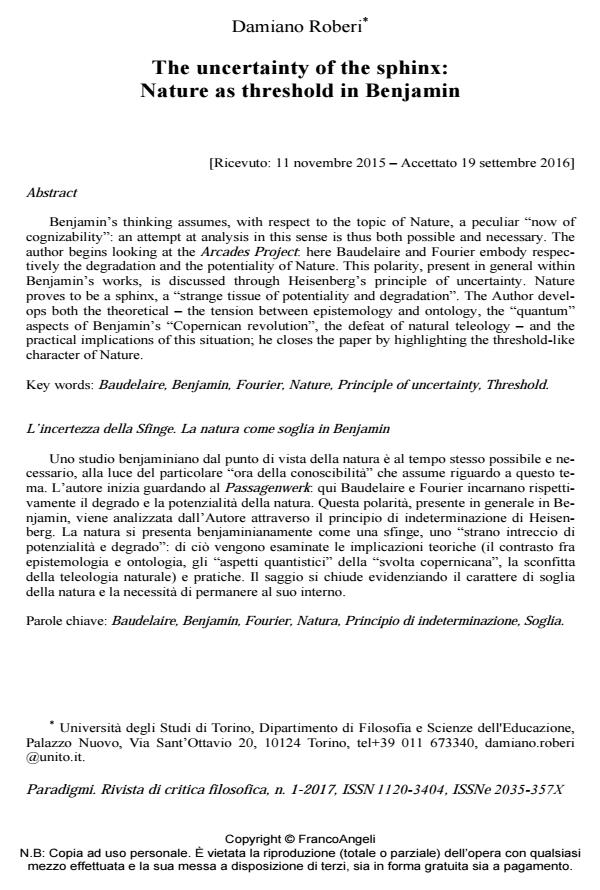The uncertainty of the sphinx: Nature as threshold in Benjamin
Titolo Rivista PARADIGMI
Autori/Curatori Damiano Roberi
Anno di pubblicazione 2017 Fascicolo 2017/1
Lingua Inglese Numero pagine 14 P. 27-40 Dimensione file 195 KB
DOI 10.3280/PARA2017-001003
Il DOI è il codice a barre della proprietà intellettuale: per saperne di più
clicca qui
Qui sotto puoi vedere in anteprima la prima pagina di questo articolo.
Se questo articolo ti interessa, lo puoi acquistare (e scaricare in formato pdf) seguendo le facili indicazioni per acquistare il download credit. Acquista Download Credits per scaricare questo Articolo in formato PDF

FrancoAngeli è membro della Publishers International Linking Association, Inc (PILA)associazione indipendente e non profit per facilitare (attraverso i servizi tecnologici implementati da CrossRef.org) l’accesso degli studiosi ai contenuti digitali nelle pubblicazioni professionali e scientifiche
Benjamin’s thinking assumes, with respect to the topic of Nature, a peculiar "now of cognizability": an attempt at analysis in this sense is thus both possible and necessary. The author begins looking at the Arcades Project: here Baudelaire and Fourier embody respectively the degradation and the potentiality of Nature. This polarity, present in general within Benjamin’s works, is discussed through Heisenberg’s principle of uncertainty. Nature proves to be a sphinx, a "strange tissue of potentiality and degradation". The Author develops both the theoretical - the tension between epistemology and ontology, the "quantum" aspects of Benjamin’s "Copernican revolution", the defeat of natural teleology - and the practical implications of this situation; he closes the paper by highlighting the threshold-like character of Nature.
Uno studio benjaminiano dal punto di vista della natura è al tempo stesso possibile e necessario, alla luce del particolare "ora della conoscibilità" che assume riguardo a questo tema. L’autore inizia guardando al Passagenwerk: qui Baudelaire e Fourier incarnano rispettivamente il degrado e la potenzialità della natura. Questa polarità, presente in generale in Benjamin, viene analizzata dall’Autore attraverso il principio di indeterminazione di Heisenberg. La natura si presenta benjaminianamente come una sfinge, uno "strano intreccio di potenzialità e degrado": di ciò vengono esaminate le implicazioni teoriche (il contrasto fra epistemologia e ontologia, gli "aspetti quantistici" della "svolta copernicana", la sconfitta della teleologia naturale) e pratiche. Il saggio si chiude evidenziando il carattere di soglia della natura e la necessità di permanere al suo interno.
Parole chiave:Baudelaire, Benjamin, Fourier, Natura, Principio di indeterminazione, Soglia
Damiano Roberi, The uncertainty of the sphinx: Nature as threshold in Benjamin in "PARADIGMI" 1/2017, pp 27-40, DOI: 10.3280/PARA2017-001003